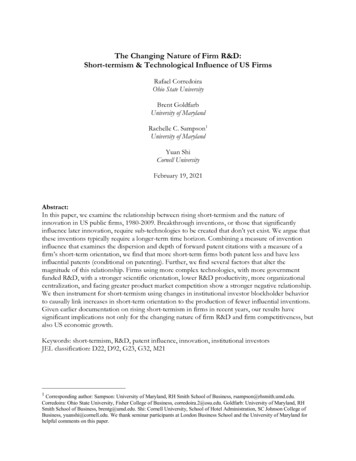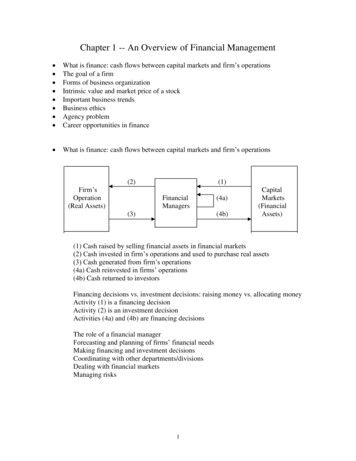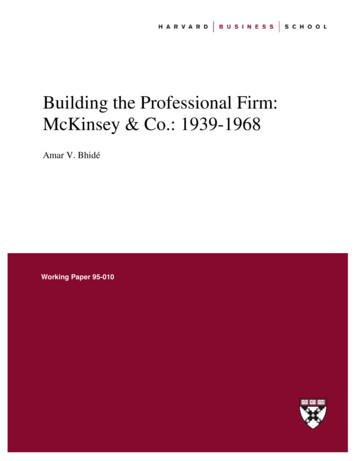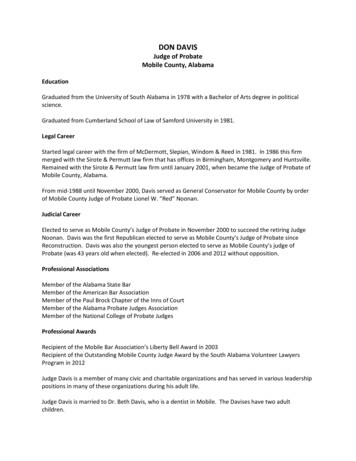
Transcription
The Changing Nature of Firm R&D:Short-termism & Technological Influence of US FirmsRafael CorredoiraOhio State UniversityBrent GoldfarbUniversity of MarylandRachelle C. Sampson1University of MarylandYuan ShiCornell UniversityFebruary 19, 2021Abstract:In this paper, we examine the relationship between rising short-termism and the nature ofinnovation in US public firms, 1980-2009. Breakthrough inventions, or those that significantlyinfluence later innovation, require sub-technologies to be created that don’t yet exist. We argue thatthese inventions typically require a longer-term time horizon. Combining a measure of inventioninfluence that examines the dispersion and depth of forward patent citations with a measure of afirm’s short-term orientation, we find that more short-term firms both patent less and have lessinfluential patents (conditional on patenting). Further, we find several factors that alter themagnitude of this relationship. Firms using more complex technologies, with more governmentfunded R&D, with a stronger scientific orientation, lower R&D productivity, more organizationalcentralization, and facing greater product market competition show a stronger negative relationship.We then instrument for short-termism using changes in institutional investor blockholder behaviorto causally link increases in short-term orientation to the production of fewer influential inventions.Given earlier documentation on rising short-termism in firms in recent years, our results havesignificant implications not only for the changing nature of firm R&D and firm competitiveness, butalso US economic growth.Keywords: short-termism, R&D, patent influence, innovation, institutional investorsJEL classification: D22, D92, G23, G32, M211Corresponding author: Sampson: University of Maryland, RH Smith School of Business, rsampson@rhsmith.umd.edu.Corredoira: Ohio State University, Fisher College of Business, corredoira.2@osu.edu. Goldfarb: University of Maryland, RHSmith School of Business, brentg@umd.edu. Shi: Cornell University, School of Hotel Administration, SC Johnson College ofBusiness, yuanshi@cornell.edu. We thank seminar participants at London Business School and the University of Maryland forhelpful comments on this paper.
1. IntroductionIn 1938, Dupont patented nylon, an enormously successful product that was the result of apurposeful, decade long basic research effort by Dupont’s corporate R&D lab (Ndiaye 2007) inwhich scientists were expected to do “pioneering research (p. 92)”. The discovery of Nylon, overtime, led to a complete restructuring of Dupont’s business. “[B]y the 1950s, in many respects,[Dupont was] a fibers company that had some other businesses on the side” (Hounshell and Smith1988). Similarly, AT&T’s patent for the transistor, a central building block of the Third IndustrialRevolution, came from Bell Labs. Eight individuals earned Nobel Prizes for work they completedwhile at Bell Labs.2 These corporate patents have been foundational in the fields of chemicals andelectronics and helped fuel the US economy for several decades.Despite these successes, Dupont and AT&T have discontinued the strategies that led tothese discoveries. Rising pressures on firms to generate short over long-term profits is one possibleexplanation for such behavior. Sampson and Shi (2020) reveal a general trend: market shorttermism, which captures contracting firm time horizons, has been increasing for public US firms.Short-termism appears to affect firm investment levels in particular circumstances (Asker, FarreMensa, and Ljungqvist 2015; Flammer and Bansal 2017; He and Tian 2013; DesJardine 2015; Davieset al. 2014). Notwithstanding this evidence that short-termism may influence corporate investment,the effects of rising short-termism on innovative output are not well understood. Firm R&Dspending has increased significantly, from 30.93B in 1980 to 297.28B in 2013 (NSF 2016).However, as suggested by the Dupont and AT&T illustrations, the nature of R&D may be changingfrom more long-term, foundational investments that spur innovation to more short-term,incremental, exploitative efforts designed to harvest existing knowledge.Knott (2017) measures a decline in RQ, a measure of R&D productivity among public firms,and documents changing strategies around how innovation is generated (Knott, 2015). Corredoira,Goldfarb & Shi (2018) find in a sample of patents granted between 2001 and 2004, that thosefunded by the government were more likely to spark follow-on innovation than those solely fundedby firms and Bernstein (2015) documents that firms going public changed R&D strategies to focuson greater external acquisition of new technologies. These results, coupled with evidence that s://www.bell-labs.com/our-people/recognition/ Viewed June26, 2018.1
firms develop less science (Arora, Belenzon, and Patacconi 2018), is suggestive evidence that a shiftin the nature of firm R&D has been taking place among firms.Thus, in this paper we focus on the potentially profound effect of short-termism on thenature of R&D investments. In our analyses below, we evaluate whether and how the nature ofinnovation in US public firms has changed over time and how any observed changes correlate withshort-termism. Using patent-based measures of influential inventions (Corredoira and Banerjee,2015), we map the relationship with short-termism. Patent influence indicates the richness of aforward patent citation tree over a finite period or, in other words, how diverse and extensive(among classes and assignees) a patent’s forward citations are. We begin by mapping out whetherpatent influence is shifting over time and find that, while there is still a group of firms that producehighly innovative patents, this group is much more concentrated than in the past. Patent influence isdeclining for most firms from 1980 to 2010.We also find that public firms that are more short-term oriented are less likely to produceprogenerative, influential patents. The effect we observe has two central components. First,leveraging within-firm variation, we report broad evidence that public firms with a more short-termorientation are less likely to patent. Second, conditional on patenting, patents by more short-termpublic firms tend to be less influential. These results are robust to the inclusion of variablesdemonstrated by prior research to bear a relationship with impactful R&D, such as firmdiversification (Seru 2014), degree of R&D (de)centralization (Argyres and Silverman 2004; Arora,Belenzon, and Rios 2014) and whether the firm is a leader or laggard in its business segment(Hashmi 2013; Aghion et al. 2002). We also find that this effect is more pronounced for firms intechnological areas that are more complex (in the sense that individual elements of a technologicalsolution are themselves discreetly patentable, Cohen, Nelson & Walsh (2000)), as well as those thatexperience higher product market competition.We present our results using both a traditional as well as an epistemic mapping approach(King, Goldfarb, & Simcoe, 2020). The latter approach maps the relationship between shorttermism and patenting across choices of patent-based innovation measures and combinations ofsampling criteria, control variables and modeling choices. We thereby provide the reader with acomprehensive map to help understand the sensitivity of the estimates to plausible empiricalassumptions.2
Several robustness checks support these general findings. Alternative measures of influentialinnovations, such as text-based measures of novelty (Fleming et al 2019) and backward patentcitations (Rosenkopf and Nerkar 2001), as well as varied sampling yield similar results.To move beyond correlational relationships and evaluate whether there is a causal impact ofrising short-termism on the nature of firm R&D, we employ an instrumental variables approach thatcaptures rising short-termism via changes in the trading behavior of institutional investors holdinglarge blocks of shares. These results show a strong negative effect of rising levels of ourinstrumented short-termism variable on influential patenting by firms.The potential implications of these results are profound. If firms are changing the nature oftheir investments, away from more fundamental and potentially path breaking R&D projects,towards those that are more incremental, they are in effect choosing shorter term, more certain, butlikely smaller gains, over longer term, less certain, but market creating gains. Depending on how thisphenomenon compares to that in other countries and given how breakthrough inventions are acritical engine of economic growth, this may signal a shift of US competitiveness. Follow up analysesshow similar patterns of declining influential inventions among US private firms as well, implyingthat our results are not just reflecting a shift of breakthrough inventions from public to privatefirms.The paper proceeds as follows. We set out a conceptual discussion of what drivesbreakthrough inventions, what it means for a firm to be short-term and the implications for thesebreakthrough inventions in Section 2. Our data and key measures are described in Section 3, alongwith descriptive graphs that show trends in influential patents (our proxy for breakthroughinventions) over time. Section 4 sets out our focal empirical results, demonstrating the persistentnegative correlation between short-termism and patent influence as well as an instrumental variablesapproach that suggests the relationship between short-termism and influence may be causal. Weconclude with a discussion of implications, limitations and future directions in Section 5.2. Conceptual background2.1 The process of breakthrough inventionsTo make a connection between breakthrough inventions and a firm’s time horizons, with themanagement priorities that follow, we first examine the process of breakthrough inventions. Basedon prior work that we presently describe, our prior is that breakthrough inventions are those wheremultiple additional technologies have to be created in order to solve the original problem that theinvention seeks to address. In other words, while incremental inventions are those that build upon3
established technologies, breakthrough inventions require creation of sub-technologies that don’t yetexist.Rosenberg’s (1963) seminal paper on the machine tool industry described how earlytechnologies were invented, subsequently improved, and then applied to a variety of applicationsover time. Rosenberg (1969) then noted that technological innovation in itself defines problems forsubsequent innovation. Arthur (2009), tidies these ideas into a structured framework that leveragesthe observation that technological innovation is recombinatory in nature (Fleming, 2001), andhierarchical in the sense that inventors leverage an existing concept or idea and this effort serves as aRosenbergian focusing device as inventors work to solve a series of technological challenges neededto render the idea operational. Early efforts to convert an idea into a working technology, that is, anartifact that does something, usually lead to initial outcomes that are not particularly useful. However,such efforts are still fruitful because they clarify not only what problems still need to be solved, butalso identify what the barriers to implementation are in the first place. That is, efforts to solve eachproblem reveal a set of sub-problems, where the solutions are embodied in technologies and subtechnologies, respectively. When ideas are novel, we expect that it will take more time to work outhow sub-technologies fit together to create an overall solution. The more new sub-technologicalproblems that need to be worked out, the longer a firm requires to work out these individualproblems.Arthur (2009) illustrates these ideas via the example of Gary Starkweather’s invention of thelaser printer at Xerox in late 1969. Starkweather came up with the fundamental idea while working inXerox’s Webster, New York, Lab. The Webster lab was organized with a sharp focus on incrementalimprovements that could be embedded in the next version of Xerox copiers. Starkweather’s laseridea, which came out of his doctoral work, was fundamentally recombinatorial in that it used the(newly invented) laser to “ paint’ an image on a xerographic drum.” When Starkweather proposedusing laser technology to produce a printer at Xerox’s Webster, NY lab, it was quickly recognizedthat creating a working laser printer was not possible by simply assembling off-the-shelf components(Hiltzik 2000). Reflecting the strategic priorities of the Webster lab, Starkweather was ordered torefocus his efforts on marginal improvements to existing, diffuse-light, CRT machines. Unhappywith this directive, and with a bit of luck, Starkweather was transferred to the newly created XeroxPalo Alto Research Center (PARC). PARC was organized completely differently, akin to anacademic department with a long-term focus. Within the organizational freedom at PARC,Starkweather had both time and resources to solve many of the sub-problems of laser printing. This4
led to the 1969 breakthrough patent. Thus, the laser printer was invented in a quasi-academicenvironment, with few restrictions on budgets and freedom to work on interesting projects. Withless restrictive budgets and mandates surrounding project scope and outcome timing, theseexamples suggest how a firm’s time horizons can impact the nature of technological investments.3In contrast to the laser printer example, Arthur considers inventions incremental when thesub-technologies are well established. An example would be the case of marginal improvements toCRT copiers. To develop these more incremental innovations, short-term horizons may suffice.When an idea is more novel, it generally requires solutions to a host of new, unanticipatedsubtechnology problems. Novel ideas are not simply more time consuming, they are more riskybecause they require solutions to additional subtechnological problems; each could wind up beingvery difficult to solve. Moreover, these new problems are difficult to anticipate ex-ante, when theoriginal idea is imagined. For successful development of very novel ideas, a longer-term orientationis needed. However, the more subtechnologies needed to realize an idea, the more likely some ofthese inventions will have broad applications, generating solutions to problems yet unimagined (i.e.,breakthrough inventions). Because such exploration is by definition more time consuming withuncertain outcomes, it likely requires longer time horizons and greater patience for returns withinthe organization itself.2.2 How does firm short-term orientation link to the nature of innovation?Research in behavioral economics and finance demonstrates the link between time horizonsand willingness to engage in riskier investments, such as more ambitious R&D projects. Further, thisresearch links the evaluation or feedback period to investor time horizons. For example, inexperiments, longer feedback periods lead to greater long-term investment (Fellner and Sutter 2009)and, when returns are aggregated over longer time periods, individuals make riskier investments(Thaler et al. 1997). Further, market prices of risky assets have been higher when feedback anddecision making is less frequent (Gneezy, Kapteyn, and Potters 2003).Firms facing pressures to deliver short-term returns (i.e., those with a shorter timeorientation) may find it difficult to invest in more novel, recombinatory R&D projects because thesetypically require solutions to a larger set of subtechnological problems requiring more time and that3While the long-term orientation of Xerox PARC has been controversial - the laser printer, eventually brought to market in 1978,earned over 2B in revenues for Xerox. The annual budget for PARC at that time was approximately 6M (Hiltzik 2000) - thus it isdifficult to claim this was not a win for Xerox. However, the time between a conception to project was over a decade. Xerox hassince scaled back the long-term orientation of its research center.5
are characterized by greater uncertainty (as noted above). Instead, these firms may prefer simplerprojects - that is, those that require more straightforward applications of current technologicalsolutions, since these will more likely lead to near term, more certain payoffs. There are twomechanisms within the firm that make more novel recombinations less likely in short-term orientedfirms.First, researchers have greater difficulty conveying the value of more novel projects, sincethese projects are usually characterized by higher information asymmetry. The laser printer exampleabove illustrates this challenge; Starkweather, who had recently graduated from a department on thetechnological frontier, struggled to convey the promise of the new LASER technology to hismanagers. Second, even if frontier ideas are well understood, the time horizons necessary forsuccess are often beyond the timelines of managers. This was certainly the case for Starkweather andthe laser technology as Starkweather’s initial requests to spend time on laser printing possibilities wasstymied by managers focused on incremental improvements to CRT copiers (Hiltzik 2000). Moregenerally, projects that require search across many potential recombinations or those that require indepth search may not only be curtailed, but eliminated. Since it is difficult to predict how differentsubtechnologies may come together to produce useful technologies, curtailing such efforts will leadto a lower likelihood of finding progenerative innovation paths that lead to breakthrough inventions.These arguments lead us to the central prediction of the paper: Short-term-oriented firms are lesslikely to produce progenerative, or influential, inventions. A secondary prediction is that the variance ofproject outcomes should be higher for long-term oriented firms as compared to short-term orientedfirms. Because of prior observations that short-termism appears to be rising for the majority of USpublicly listed firms (Sampson and Shi 2020), implications extend beyond firm performance to theeconomy as a whole. We note, however, the extensive heterogeneity across firms in the level ofobserved short-termism means that some firms are still likely engaged in longer term, riskierprojects.Importantly, firms and investors may prefer to have a short-term orientation. Establishingthat there is a relationship between short-termism and both the extent and quality of patentingoutput on average in public firms does not necessarily imply that we ought to be concerned. Wereturn to this discussion and debate after we have presented our description of the impact of shorttermism on innovative output.6
2.3 Sources of firm heterogeneity in the relationship between short-termism andinfluential inventionsWe expect that firm heterogeneity adds variance to the expected relationship between shorttermism and influential inventions. The literature evaluating relationships among firm characteristics,such as size, incumbency and organizational form, industry competitive dynamics and innovation isvast, revealing significant nuance in these relationships across firms and industries (see, e.g., Cohen2010 for a relatively recent review of this literature). From this literature, however, we identify threekey characteristics that may explain any observed heterogeneity in the relationship between shorttermism and influential inventions. These include the extent of diversification, the degree ofcentralization of a firm’s R&D program, and whether a firm is a leader or laggard in an industry.The extent of diversification within a firm has been argued to alter the incentives to invest inmore innovative projects. (Porter 1992) argued that conglomerates may be ill suited to moreinnovative projects. This may be due to the informational distance between divisions, which areclose to the research, and headquarters (HQ), where funding decisions are made. Scherer (1999)notes that researchers or managers closest to the actual R&D projects have access to more tacit (or‘soft’) information as to the quality of the projects. Credibly communicating this information to thedecision-making HQ is the source of the funding problem; HQ cannot be sure that researchers ordivision managers won’t distort information to ensure support for division R&D activities. Seru(2014) argues that, because of this anticipated information manipulation, HQ may optimally decidenot to embark on more novel projects characterized by more uncertain outcomes. Anticipating this,divisional managers may propose only more certain, but incremental, projects to HQ (Rotembergand Saloner 1994). Over time, this phenomenon would be expected to change the nature of R&Dwithin diversified firms toward these incremental projects. Thus, we expect that influentialinventions are less likely for more diversified firms. Further, we expect that rising short-termismwithin such firms will exacerbate this move away from ambitious projects as diversificationincreases. In other words, the extent of diversification may explain why some firms have a morenegative relationship between short-termism and influence. Investors may rationally anticipate lowerlong-term returns to R&D for more diversified firms.Closely related to diversification is the extent of decentralization of a firm’s R&D program.The degree of (de)centralization of R&D reflects both where R&D is conducted in the firm andwhere project funding decisions are made (i.e., HQ or divisions). Such decentralization has beenproposed as a mechanism to commit resources to more novel R&D projects, since the decision7
making power over project continuation rests with the division manager (Seru 2014). More optimaltradeoffs are possible given the stronger incentives possible with assigning decision rights closer tothe information source; the tendency to distort information is reduced and division managers aremore likely to terminate underperforming projects (Aghion and Tirole 1997). These argumentssuggest that more experimental projects would take place in firms with more decentralized R&D. Incontrast, Arora et al., (2014) find that more basic research, which bears a stronger link withinfluential inventions since basic research is characterized by projects without clear applications andcertain payoffs similar to the novel recombinations that facilitate influential inventions, is more likelyin firms with centralized R&D programs. We expect this effect to persist only for diversified firms.Whether decentralization supports more novel projects, improving the likelihood of influentialinventions, depends on whether the firm is a diversified, multi-business firm. If the firm is a singlebusiness firm, then the difference empirically between decentralized and centralized R&D collapses.Overall, it appears that a cluster of firm characteristics make influential inventions less likelyand that rising short-termism will exacerbate these effects. Further details are contained in ourdiscussion of the measures that capture these constructs below.3. Data description: Sample & MeasuresTo evaluate whether firms with a short-term time horizon produce less influentialinventions, we combine firm level, patent citation data with a market-based measure of shorttermism. Our sample for estimation consists of all firms publicly listed on major US stock exchanges(i.e., NYSE/AMEX and NASDAQ) for the period 1980-2009. The short-termism measure requiresfive consecutive years of stock market data for each listed firm; thus, we exclude public firms listedfor fewer than five years.43.1 Dependent variables capturing breakthrough inventionsWe create two primary measures to capture the impact of a firm’s inventions on subsequentinnovation, using patent grant and application information collected from PATSTAT Global andthe NBER dataset. Our sample includes all the USPTO applications for utility patents withapplication dates between January 1, 1976 and December 31, 2016 and corresponding patentsgranted before July 31, 2018. With this data, we calculate the influence and impact for patents4We also exclude over the counter stocks as well as firms that have undergone changes that trigger a change in CUSIP identifier inthe past five years. These changes include name change, (reverse) stock split, and restructuring (FINRA, 2016).8
granted during the period 1980-2009. These variables are calculated according to the followingdefinitions and are aggregated annually at the firm portfolio level.Patent Impact captures the technological impact of a focal patent by the citations receivedfrom subsequent patents granted within 7-years of the publication date of the focal patent (but nolater than 2018). Patent Influence captures the direct and indirect impact of a patent over a definedtime window (Corredoira and Banerjee 2015; Corredoira, Goldfarb, and Shi 2018). Patent Influence isdefined as:!"# %# &%'() %* ./1(1 . 23. ),where 1 is the attenuation factor (in this study 1 1), k is the citation generation, AT is thetranspose of the adjacency matrix defined by patent citations. Intuitively, this measure captures howmany generations of patent trees are built upon a focal patent. In other words, the influence of apatent is the column sum of the matrix 1 . 23. . The citation tree defining the adjacency matrix iscomposed of all direct and indirect citations received by the focal patent from patents grantedbefore 2018 and with publication date in the 7-year window following the publication date of thefocal patent, conditional on having an application date later than that of the focal patent. As a result,Patent Influence reflects how much the focal patent has contributed to subsequent inventions, withlarger scores reflecting greater long-term utilization of the knowledge embedded in a focal patent.Due to the incentive structure of incentives in the patent system, patents, unlike academicliterature, cite only their immediate antecedents – creating a de facto barrier to assess the influencebeyond the direct antecedents. Therefore, capturing indirect citations with patent data is particularlyimportant to identify dead paths or expansion into new frontiers. (Figure 1 shows an example of atechnology network and its adjacency matrix). Patent Impact and patent Influence have distributions withvery long right tails. Following Corredoira and Banerjee (2015) and Corredoira, Goldfarb, and Shi(2018), we take the natural logs of Patent Impact and Patent Influence.Over our period of observation there have been systemic changes in patenting regimes andan overhaul of the patenting system that, among other things, resulted in different rules for theattribution of priority, and the publication of documents with the consequent increase in citations toapplications. The implementation of these processes resulted in an increase in the number ofcitations to patent applications. Citations to applications were negligible before 2000, but by the2010s well above 50% of patent citations were to applications. In addition to this change, patentsalso show systematic differences in the average number of citations over time and across classes. Forthese reasons we standardized the variables of interest.9
We standardize these measures using a z-score, constructed by dividing the focal patent’simpact or influence by the standard deviation of all patents’ impact or influence in the focal patent’sprimary class in a given year. We drop all patents assigned to main classes with fewer than 30 patentapplications in that year. We chose not to subtract the average or median from the z-scores, sincenot doing so allows a more natural interpretation given that the citation measures are all boundedbelow by 0. That is, the z-score measures the number of standard deviations from 0 in a given year.In this way, we are anchoring all the values to the zero of each measure, a value with the samemeaning for all the classes and years.We note that the distributions of values for Patent Impact and Patent Influence show very longtails, and we are particularly interested in the top of the distribution, since those are the inventionspresenting breakthrough characteristics. Thus, we estimate the effect of firm short-termism on theaverage and the 95th percentile of a firm’s portfolio for Patent Impact and Patent Influence.3.2 Focal independent variable: Firm short-termismAs a proxy for a firm’s time horizons, we use a measure employed by Sampson and Shi(2020) that estimates an implied discount rate used in the valuation of firm assets. The measure isderived from an asset pricing model first proposed by Miles (1993) and Davies et al. (2014). Simplyput, we estimate the rate at which investors discount the expected future cash flows of a firm aboveand beyond firm-specific risk premium. The basic rationale is that a shorter time horizon, orstronger short-termism pressure, leads firms to focus heavily on near-term returns and to place lessemphasis on returns from the more distant future, thus resulting in a much steeper discount rate forcash flows in later periods. Conceptually, we use a dividend discount model and treat stock price offirm j at time t as the net present value of its future cash flows over the next N periods:5(4)where P is the stock price, Et[Djt N] is the expected value of firm j’s dividends in future period t N,rt is the market risk free rate, πjt is firm j’s risk premium, and N is the number of time periods used inthe estimation of the current stock price. Et[Pjt N] is the expected value of the terminal stock price atthe end of the time window, t N. The firm specific risk premium is defined as:πjt α1 βjt α2Zjt(5)5While we consider dividends and stock prices in the main model, Sampson and Shi (2020) further demonstrate thevalidity of th
from more long-term, foundational investments that spur innovation to more short-term, incremental, exploitative efforts designed to harvest existing knowledge. Knott (2017) measures a decline in RQ, a measure of R&D productivity among public firms, and documents changing strategies arou










